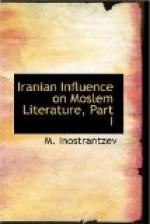[Footnote 1: In the text the term is Zadan Farrukh, but Justi already in his Iranisches Namenbuch in 1895 proposed the reading Zadan Farrukh.]
[Footnote 2: As regards the first, see my Materials from Arabic Sources, page 68-69. For the second, West Pahlavi literature G.I. Ph. II, 112. For the third, in Pahlavi verse West 113. For Musalman times see Schefer Chrestomathy 3-6 and Salemann and Zukovski, Persian Grammar page 41-49. Also compare Melanges Asiatiques IX, 215. In Arabic Anthologies especially of the character of what is known as Furstenspiegel the maxims of this wise Wazir are very frequently quoted. See for instance, Sirajul Mulk of Tartushi, also compare the bibliography in V. Chaubin, of Arabic works, Leige 1892, page 66.]
Alongside of this most celebrated Pand Nameh in the Pahlavi literature are also famous a number of other analogous literary monuments traceable to definite persons, while some are anonymous. They are of a nature, for instance, of a simple testament from father to son[1].
[Footnote 1: West 109-111, and 113-115.]
As we have already observed, and as we shall have occasion to speak further, this category of literary remains undoubtedly survived in the Musalman literature and partly in the literature of the Arabs. For the study of the Pahlavi literature this class of tracts has already evoked attention and has called forth several editions and translations. We notice that their interest goes beyond that of Pahlavi literature proper and they are important also for the history of the literature of Musalman nations. Moreover, they are of interest from a general point of view, for the study of Musalman culture. In fact, by their very character these works are brief catechisms with no pretensions to abstract theoretical acquaintance with the sacerdotal tracts, composing another important section of Pahlavi literature, but immediately connected with the daily ordinary life. It goes without saying that whoever read them in the original, their interest did not lie in their theoretical character, but that they were rendered into Arabic and modern Persian languages with a view to the same practical end. Hence however monotonous they are,[1] whatever wearisome character these books possess, they are of great interest for the purpose of comparison with similar productions of Musalman literature and for the purpose of establishing their influence in the unfolding of ethical ideas of the Musalman east, which are far from being clearly made manifest. This side of the question deserves, in my opinion, in these days ampler attention and research.
[Footnote 1: See Noeldeke “Persische Studien” II, S.B.W.A, 1892, 29, Noeldeke remarks, with reference to this class of literature, “that the investigation of this fatiguing business demands an unusual amount of patience”, see for instance, the comparison instituted between ethical norm in the Parsi and in the Musalman Literature by Darmesteter in Revue Critique, 21, 1-8.]




